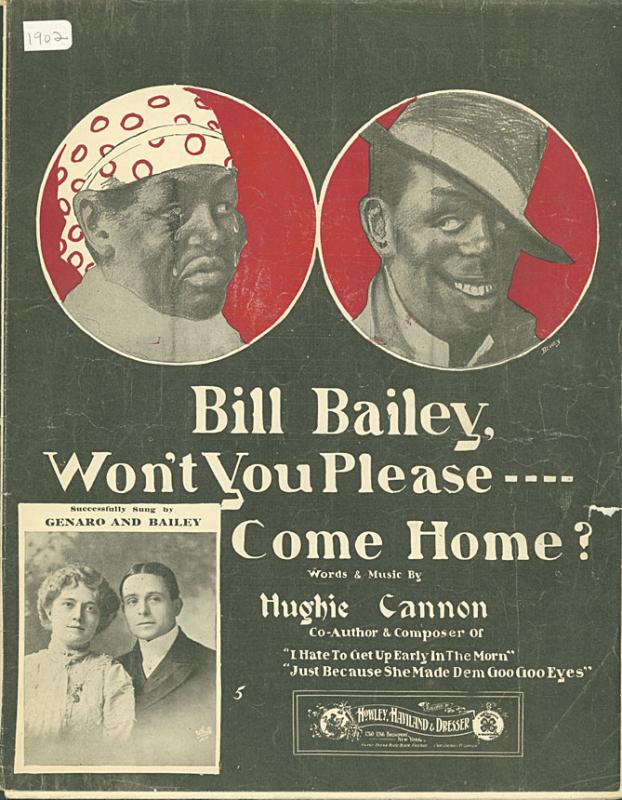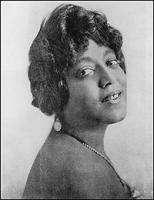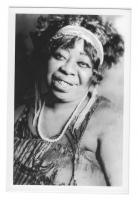Twelve-bar Blues
As a musical genre, the blues was a fad introduced in the early years of the recording industry. Like the other genres that circulated on records at the time, blues had deep roots in regional musical cultures, but also in commercial forms such as minstrelsy and vaudeville. But what distinguishes blues is its enormous staying power, both as a musical genre unto itself and as a form used heavily by musicians in other genres, including jazz, country, and rock. In fact, it’s impossible to imagine any of these genres without the blues.
The idea of the blues as an expression of Black sadness derives from the minstrel show. Songs like “Bill Bailey” and “Old Black Joe” packaged Black suffering as an authentic emotional experience for white consumers. When African American performers began to appear in blackface at the end of the nineteenth century, they mocked and redefined these stereotypes.
The notion of blues as a distinct musical form emerged in the 1910s, when songwriters such as W.C. Handy developed a standardized chord progression and lyrical pattern. Over the years, blues musicians have often departed from this formula, and yet these structures still inform our expectations when we hear or play blues. When a song in another genre is said to be a blues, often it’s these structures that are being referenced.
So what is the basic blues formula?
It's a repeating cycle of twelve bars (a bar, in this case, is made up of 4 beats: 1,2,3,4). Over the course of those twelve bars, the musicians will play three particular chords in a particular order. The chords are the I, IV, and V: chords built from the first, fourth, and fifth notes in the major scale of whatever key the musicians are playing in. So, in the key of C, the three chords would be: C, F, G (If you say the alphabet from C while counting on your fingers, you’ll see that F and G are four and five). Here’s the order of the chords over 12 bars:
The lyrical pattern that fits over this pattern is AAB, meaning that the singer sings one line (A) over the first four bars, then repeats it over the next four, and then sings a second line over the last four bars. The last word of B usually rhymes with the last word of A.
Marie Cahill's recording of the Dallas Blues from 1917 is a clear example of the format.
In this early period, when blues songs were novelty numbers sung by white vaudeville singers like Cahill, the 12-bar format was not rigidly applied; plenty of blues songs departed from the formula. Marion Harris was billed as the “Queen of the Blues,” but her most famous recording, “I Ain’t Got Nobody Much” was not a 12-bar blues.
So what other musical elements could indicate a blues song? Beginning in W.C. Handy’s day, blues music also implied both the use of certain notes and certain ways of playing notes. The melodies that blues musicians played often featured so-called “blue notes” -- notes that are not in the major scale and therefore add tension. Moreover, blues musicians also tended to bend pitches, creating musical interest by purposefully playing a “wrong” note on the way to the “right” one. Pitch-bending like this probably has a long history in many genres, but it also featured in the minstrel show as an indicator of Black musical style, so both musicians and listeners would have had that association.
After Mamie Smith’s “Crazy Blues” inaugurated the race records era in 1920, African American women took over the category of “blues singer.” Singers like Cahill and Harris were imitating Black styles; now consumers could hear the “real thing.” These new Black singing stars stretched the artistic possibilities afforded by blues conventions, and they often treated the genre as an opportunity for serious, emotional expression rather than lighthearted entertainment.
Listen to Ma Rainey’s “Barrel House Blues," recorded in 1923, for an example. Using a strict 12-bar structure, the song describes the hardships of prohibition. Check out how Rainey subtly bends the pitch on the word “awfully,” a blue note. You can also hear bent or slurred pitches in the performances of the musicians: Lovie Austin on piano, Tommy Ladnier on cornet, and Jimmy O’Bryant on clarinet.
In subsequent decades, blues remained a genre, but it also came to constitute an idiom available to popular musicians in a range of other styles. When a rock guitarist plays a blues lick or when a jazz quartet plays the 12-bar chord progression, they evoke the pathos and gritty authenticity with which early artists imbued the genre.




